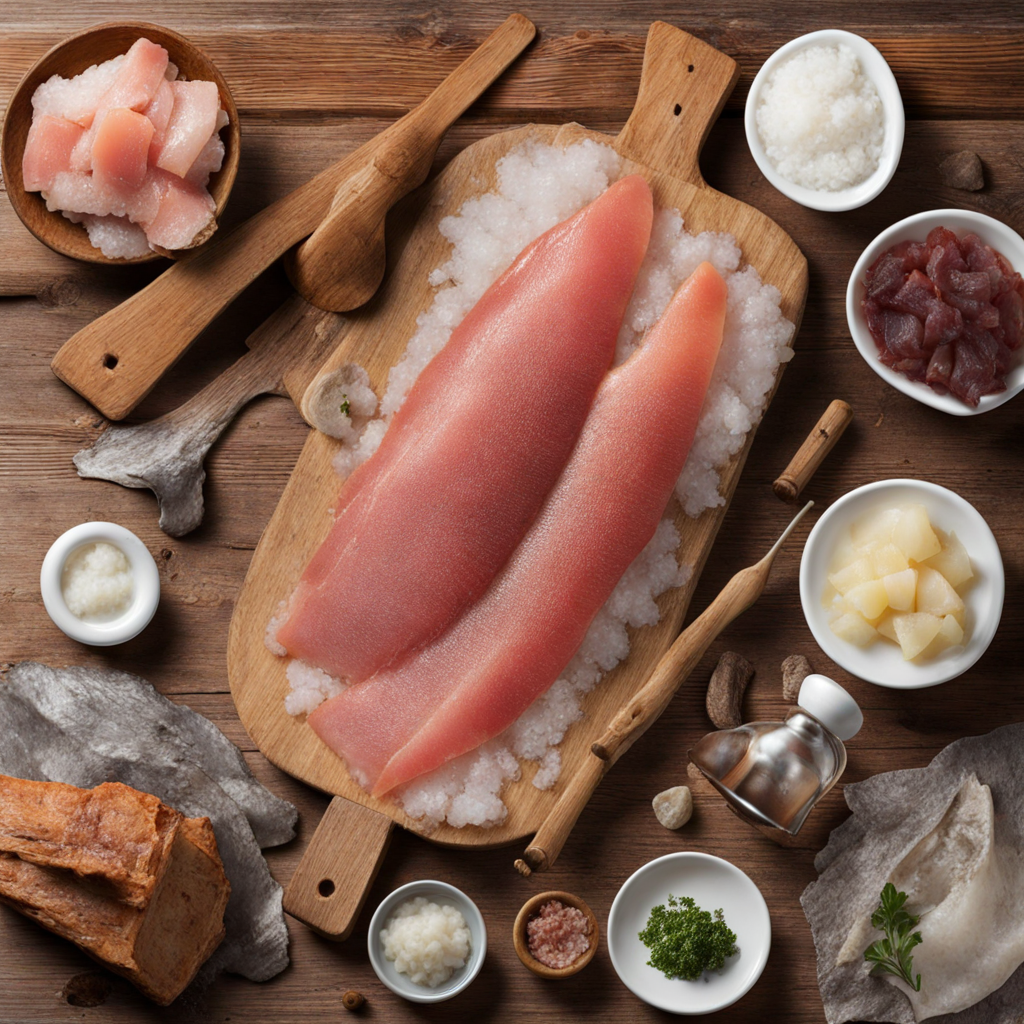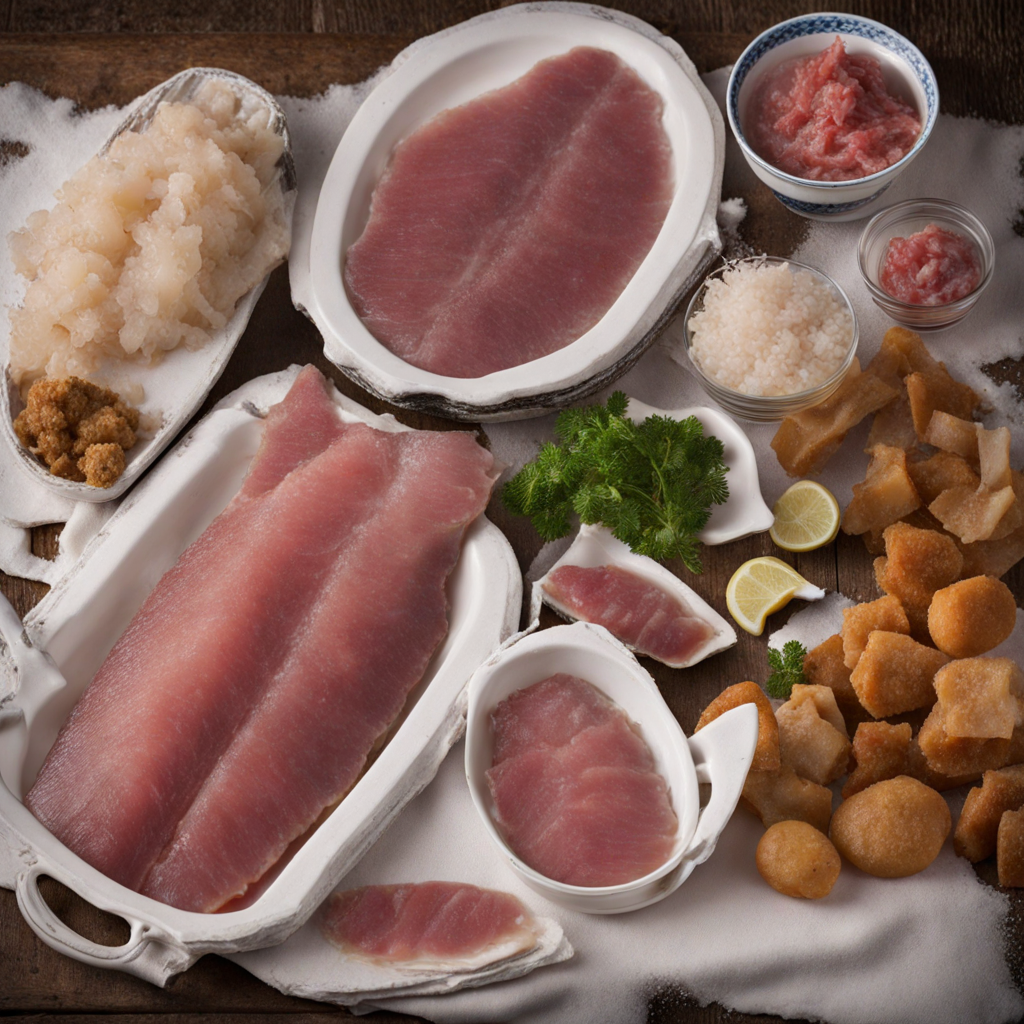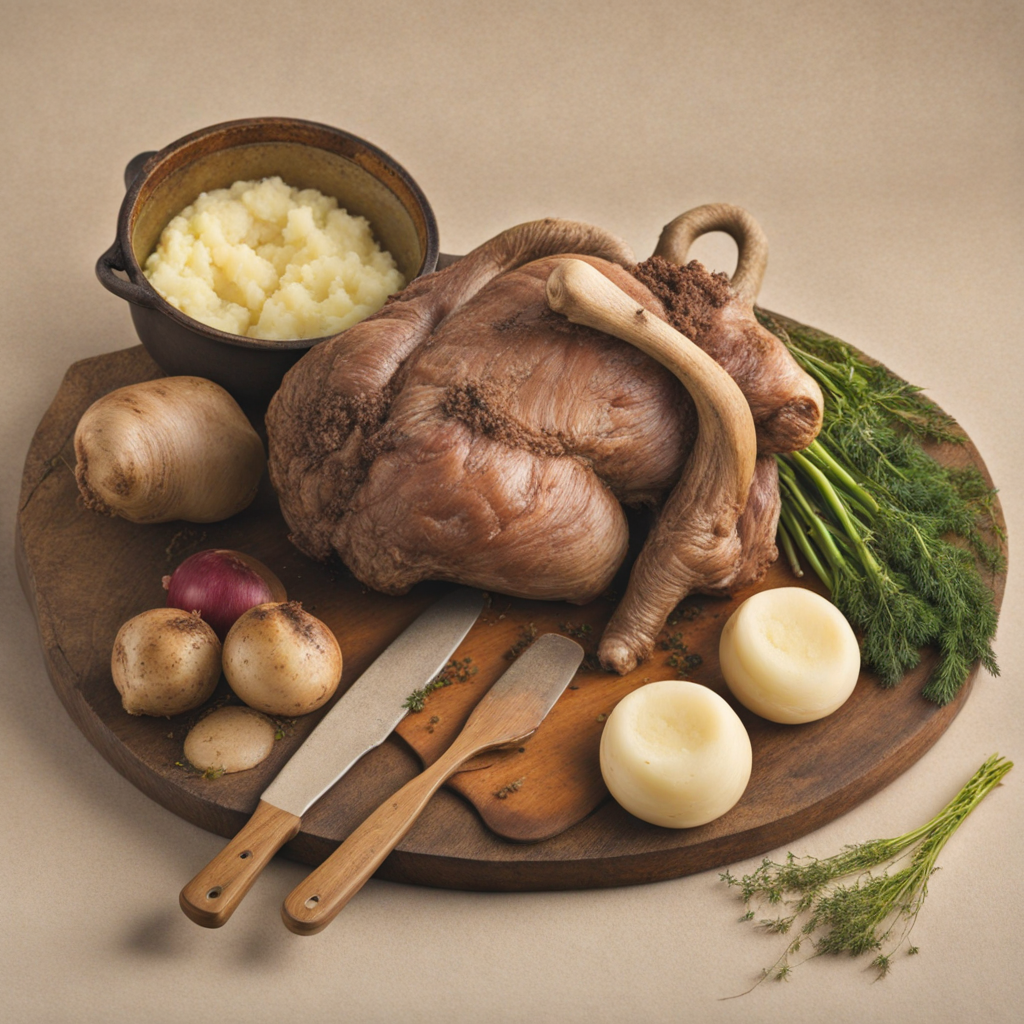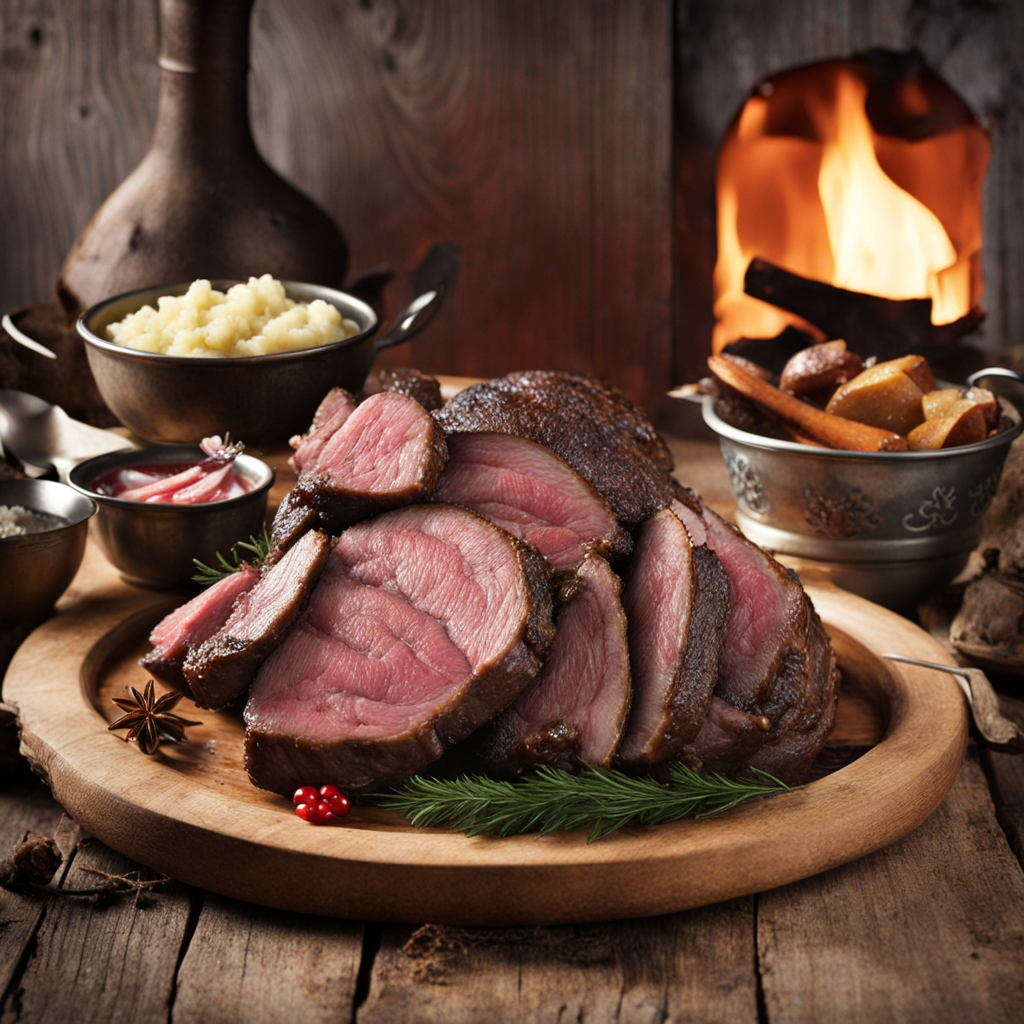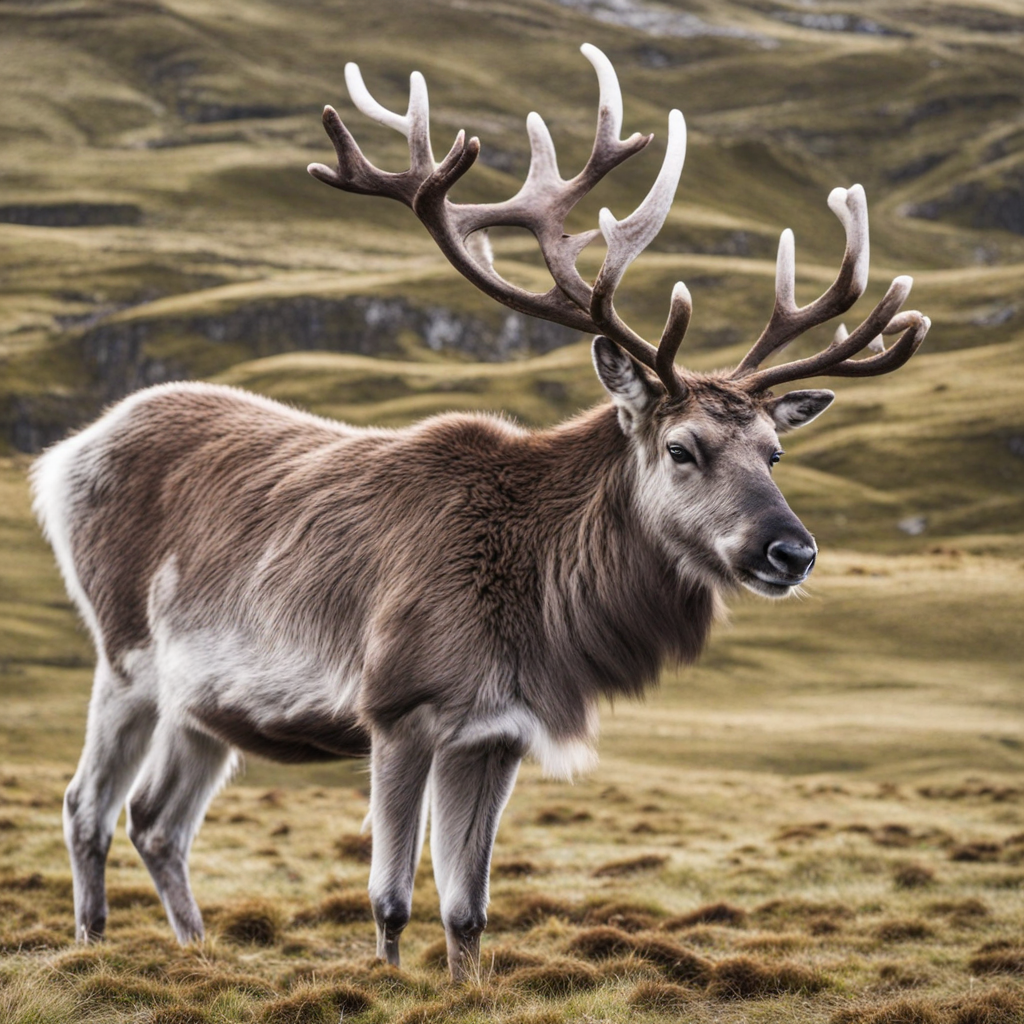Hákarl
Hákarl is a traditional Icelandic dish made from fermented shark, specifically the Greenland shark. The preparation of Hákarl is a meticulous process that begins with catching the shark, which is then cleaned and buried in a shallow pit for several months. This fermentation process is essential, as it helps eliminate the toxic compounds found in the raw meat due to the shark's diet, transforming it into a delicacy that has a strong cultural significance in Iceland. Once the fermentation is complete, the shark is cut into strips and hung to dry for several more months, creating a unique texture that is both chewy and firm. When it comes to flavor, Hákarl is known for its pungent aroma, which can be quite overwhelming for those unaccustomed to it. The taste profile is often described as earthy and slightly ammonia-like, with hints of fishiness that come from its marine origins. While it may not be for everyone, adventurous eaters often find the experience rewarding, as it represents a unique piece of Icelandic heritage. Hákarl is commonly served in small cubes, often accompanied by a shot of Brennivín, a local schnapps that helps to cut through the strong flavors and cleanse the palate. For those daring enough to try Hákarl, the experience is about more than just the food; it’s about embracing the traditions and stories behind it. This dish is often served at social gatherings or festivals, where it becomes a conversation starter and a rite of passage for visitors. Whether enjoyed as a cultural curiosity or as part of a bold culinary adventure, Hákarl offers a distinctive taste of Iceland that reflects the resilience and resourcefulness of its people in utilizing the ingredients available to them, even in the harshest of climates.
How It Became This Dish
Origins of Hákarl Hákarl, a traditional Icelandic dish, has its roots deeply embedded in the Viking Age, around the 9th century when Norse settlers arrived in Iceland. The harsh and unforgiving climate of the island posed significant challenges for food preservation. Fresh fish was abundant, but without modern refrigeration, preserving this resource became essential for survival during the long winters. The solution lay in the fermentation of Greenland shark, known scientifically as *Somniosus microcephalus*. This method allowed the locals to utilize the shark's meat, which is toxic when fresh due to high levels of urea and trimethylamine oxide. By fermenting the flesh and then drying it, the Icelanders turned a potentially deadly food source into a culinary staple. The process of making Hákarl is both an art and a science, steeped in tradition. The shark is first beheaded and gutted, then buried in a shallow pit filled with gravel and sand. This is typically done in the spring, when the temperature is cool enough to facilitate fermentation without spoilage. The shark is allowed to ferment for several months, during which time it undergoes a chemical transformation that makes it safe to eat. After fermentation, the meat is hung to dry for several more months, resulting in a distinctive flavor and texture that has become synonymous with Hákarl. \n\n Cultural Significance Hákarl is more than just food; it is a symbol of Icelandic resilience and ingenuity. For centuries, it has been a part of the Icelandic diet, especially during times when other food sources were scarce. The dish embodies the spirit of survival, showcasing how the Icelanders turned a challenging environment into an opportunity for culinary creativity. It is often served with a shot of Brennivín, a potent Icelandic schnapps, which complements the strong flavors of the fermented shark. The cultural significance of Hákarl extends beyond its nutritional value. It is often featured in traditional celebrations and gatherings, serving as a source of national pride. During Þorrablót, a midwinter festival that celebrates Icelandic heritage, Hákarl is served alongside other traditional foods. This festival is a time for locals to come together, honoring their history and the unique foods that define their culture. The act of consuming Hákarl has become a rite of passage for many visitors to Iceland, a culinary challenge that tests their palate and willingness to embrace the unfamiliar. \n\n Development Over Time Over the centuries, the preparation and consumption of Hákarl have evolved, yet the core methods have remained largely unchanged. In the past, the dish was an essential source of protein during the long, harsh winters when fresh food was scarce. However, as Iceland modernized and its economy diversified, the necessity of Hákarl diminished, and it became more of a delicacy rather than a staple food. Today, Hákarl is often served as a novelty for tourists eager to experience authentic Icelandic cuisine. Many restaurants in Reykjavík offer it as part of a tasting menu, emphasizing its unique taste and the story behind its preparation. While locals may consume Hákarl more sparingly, it remains a beloved traditional food, often enjoyed during special occasions or family gatherings. The dish's reputation has also been bolstered by its inclusion in food documentaries and travel shows, where it is often portrayed as one of the most extreme foods in the world. \n\n The Taste and Experience Describing the taste of Hákarl can be quite challenging. The dish has a strong, pungent aroma that can be off-putting for some. The flavor profile is distinctly fishy, with a hint of ammonia due to the fermentation process, often described as an acquired taste. When consumed, Hákarl has a chewy texture that contrasts with the soft and tender meat of other seafood. The experience of tasting Hákarl is often enhanced by the setting in which it is served. Many locals enjoy it in a communal atmosphere, sharing the dish amongst friends and family. The ritual of tasting Hákarl alongside Brennivín adds to the overall experience, as the schnapps helps to cut through the richness of the dish. This combination is not only a culinary pairing but a cultural one, reinforcing the bond between food and identity in Iceland. \n\n Modern Perception and Challenges In contemporary times, Hákarl has faced both admiration and criticism. While many Icelanders take pride in their traditional cuisine, some younger generations are moving away from it in favor of more global food trends. The dish's strong aroma and unique texture may deter some from trying it, leading to a perception of Hákarl as an exotic or extreme food. Nevertheless, there is a growing movement focused on preserving Icelandic culinary traditions, with Hákarl sitting at the forefront of this cultural renaissance. Additionally, the sustainability of sourcing Greenland shark has become a topic of discussion among environmentalists and food activists. Concerns about overfishing and the impact on marine ecosystems have prompted debates on how traditional foods like Hákarl can be enjoyed responsibly. Efforts are being made to ensure that the harvesting of sharks is sustainable and mindful of ecological balance, thus preserving not only the dish but also the environment that allows it to exist. \n\n Conclusion Hákarl stands as a testament to the resourcefulness of Icelandic culture, a dish that has survived through centuries of change. It encapsulates a deep connection to the land, the sea, and the history of a people who have adapted to their environment in remarkable ways. As Iceland continues to grow as a culinary destination, Hákarl remains an integral part of its identity, inviting both locals and travelers to explore the flavors of an ancient tradition that is as rich as the landscape itself.
You may like
Discover local flavors from Iceland


